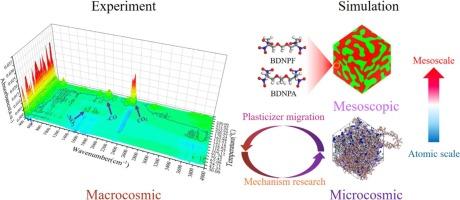乙酸丁酸纤维素(CAB)中丁基取代度对A3增塑剂迁移的影响:机理分析
IF 12.5
1区 化学
Q1 CHEMISTRY, APPLIED
引用次数: 0
摘要
增塑剂迁移是高分子材料利用中的一个重要问题。对于被两个或两个以上不同基团取代的纤维素衍生物,如醋酸丁酸纤维素(CAB),乙酰基和丁基的不同比例导致不同的化学结构,从而影响增塑剂的迁移性能。本文通过实验测试和分子动力学模拟研究了丁基取代度对增塑剂迁移性能的影响。实验和模拟结果表明,随着温度的升高,混合体系中的增塑剂随着CAB丁基取代量的增加更容易发生迁移。微观和介观机理研究表明,增塑剂和CAB之间的分子间作用力强度并不是增塑剂迁移差异的主要原因。其主要原因是随着丁基取代度的增加,位阻效应和增塑剂迁移途径的减弱。本文章由计算机程序翻译,如有差异,请以英文原文为准。

Effect of butyryl substitution degree in cellulose acetate butyrate (CAB) on A3 plasticizer migration: Mechanism analysis
Plasticizer migration is a significant issue in the utilization of polymer materials. For cellulose derivatives substituted with two or more different groups, such as cellulose acetate butyrate (CAB), the varying proportions of acetyl and butyryl groups lead to different chemical structures, which influence the plasticizer migration properties. This paper investigates the effects of the butyryl substitution degree on plasticizer migration properties through experimental testing and molecular dynamics simulations. Results from experiments and simulations indicate that as the temperature increases, the plasticizer in the mixed system is more likely to migrate with the increase in CAB butyryl substitution. Microscopic and mesoscopic mechanism studies reveal that the strength of intermolecular forces between the plasticizer and CAB is not the primary reason for the differences in plasticizer migration. The main reasons could be attributed to the reduction in steric hindrance effect and plasticizer migration pathway as the degree of butyryl substitution increases.
求助全文
通过发布文献求助,成功后即可免费获取论文全文。
去求助
来源期刊

Carbohydrate Polymers
化学-高分子科学
CiteScore
22.40
自引率
8.00%
发文量
1286
审稿时长
47 days
期刊介绍:
Carbohydrate Polymers stands as a prominent journal in the glycoscience field, dedicated to exploring and harnessing the potential of polysaccharides with applications spanning bioenergy, bioplastics, biomaterials, biorefining, chemistry, drug delivery, food, health, nanotechnology, packaging, paper, pharmaceuticals, medicine, oil recovery, textiles, tissue engineering, wood, and various aspects of glycoscience.
The journal emphasizes the central role of well-characterized carbohydrate polymers, highlighting their significance as the primary focus rather than a peripheral topic. Each paper must prominently feature at least one named carbohydrate polymer, evident in both citation and title, with a commitment to innovative research that advances scientific knowledge.
 求助内容:
求助内容: 应助结果提醒方式:
应助结果提醒方式:


